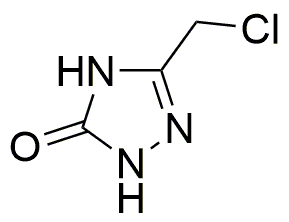3-(Chloromethyl)-1,2,4-triazolin-5-one is widely utilized in research focused on:
- Agricultural Chemistry: This compound serves as an effective intermediate in the synthesis of agrochemicals, particularly fungicides and herbicides, helping to protect crops from pests and diseases.
- Pharmaceutical Development: It is explored for its potential in developing new medications, especially in the field of anti-infectives, due to its unique triazole structure that can enhance bioactivity.
- Material Science: The compound can be used in creating specialty polymers and coatings, offering improved durability and resistance to environmental factors.
- Analytical Chemistry: It acts as a reagent in various analytical methods, aiding in the detection and quantification of other chemical substances, which is crucial for quality control in manufacturing.
- Research in Biochemistry: This chemical is studied for its role in biochemical pathways, providing insights into enzyme inhibition and potential therapeutic targets.
General Information
Properties
Safety and Regulations
Applications
3-(Chloromethyl)-1,2,4-triazolin-5-one is widely utilized in research focused on:
- Agricultural Chemistry: This compound serves as an effective intermediate in the synthesis of agrochemicals, particularly fungicides and herbicides, helping to protect crops from pests and diseases.
- Pharmaceutical Development: It is explored for its potential in developing new medications, especially in the field of anti-infectives, due to its unique triazole structure that can enhance bioactivity.
- Material Science: The compound can be used in creating specialty polymers and coatings, offering improved durability and resistance to environmental factors.
- Analytical Chemistry: It acts as a reagent in various analytical methods, aiding in the detection and quantification of other chemical substances, which is crucial for quality control in manufacturing.
- Research in Biochemistry: This chemical is studied for its role in biochemical pathways, providing insights into enzyme inhibition and potential therapeutic targets.
Documents
Safety Data Sheets (SDS)
The SDS provides comprehensive safety information on handling, storage, and disposal of the product.
Product Specification (PS)
The PS provides a comprehensive breakdown of the product’s properties, including chemical composition, physical state, purity, and storage requirements. It also details acceptable quality ranges and the product's intended applications.
Certificates of Analysis (COA)
Search for Certificates of Analysis (COA) by entering the products Lot Number. Lot and Batch Numbers can be found on a product’s label following the words ‘Lot’ or ‘Batch’.
*Catalog Number
*Lot Number
Certificates Of Origin (COO)
This COO confirms the country where the product was manufactured, and also details the materials and components used in it and whether it is derived from natural, synthetic, or other specific sources. This certificate may be required for customs, trade, and regulatory compliance.
*Catalog Number
*Lot Number
Safety Data Sheets (SDS)
The SDS provides comprehensive safety information on handling, storage, and disposal of the product.
DownloadProduct Specification (PS)
The PS provides a comprehensive breakdown of the product’s properties, including chemical composition, physical state, purity, and storage requirements. It also details acceptable quality ranges and the product's intended applications.
DownloadCertificates of Analysis (COA)
Search for Certificates of Analysis (COA) by entering the products Lot Number. Lot and Batch Numbers can be found on a product’s label following the words ‘Lot’ or ‘Batch’.
*Catalog Number
*Lot Number
Certificates Of Origin (COO)
This COO confirms the country where the product was manufactured, and also details the materials and components used in it and whether it is derived from natural, synthetic, or other specific sources. This certificate may be required for customs, trade, and regulatory compliance.


